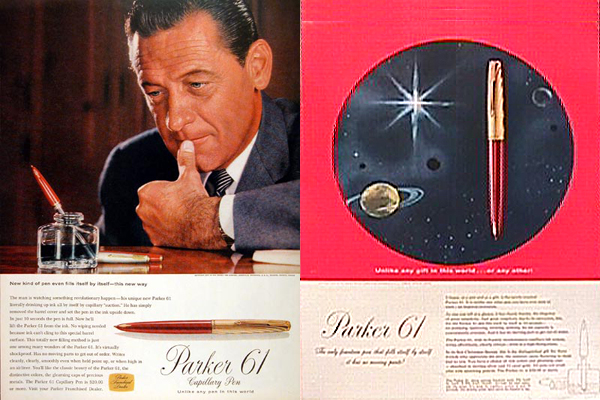
| parkerpens.net |
| PARKERCOLLECTOR.COM |
 1956-1983 |
||
There were three downsides to the fountain pens of the 1950's. The ball pen had arrived and the public was enchanted by this new pen that didn't need to be filled from a bottle and didn't cause ink stains. There had been many different solutions for keeping hands clean. The most successful up to then was the Sheaffer Snorkel, introduced in 1952. It utilised a sort of syringe under the ink feed that could be inserted into the ink and then screwed into the pen again after filling. No need to wipe a stained nib.
|
Don Doman had an easy and attractive solution to the problem. He proposed an inlaid arrow on the gripping section, just above the nib. Initially there plans to glue the arrow to the body but Doman argued that the arrow then would too easily fall off. He wanted the arrow to be insert moulded flush with the section surface. Engineers in turn argued that a moulding process would prove too expensive and difficult, but Doman persisted. Of course all latter day Parker "61" collectors are well aware of the arrows constantly falling off, even with the arrows moulded. Had Doman not had his way I suspect few arrowed Parker "61" would have survived at all. Even though the pen eventually consisted of few parts the manufacturing costs was still high in reelation to the benefits. While the filling system had no moving parts it still required the user to sometimes wipe down the teflon tube after filling, and furthermore, since most users didn't want to bother with keeping their wrtiting instrument clean, they seldom had it washed or flushed clean of ink. Hence it eventually clogged. |
|
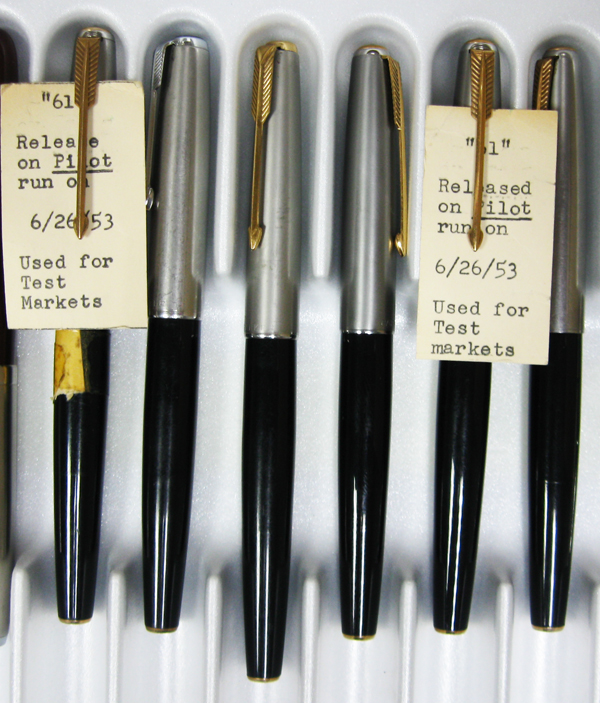 Photography © 2009 by Tony Fischier courtesy of The Parker Pen Company Archives. |
Six prototype Parker "61" from the Experimental Archives |
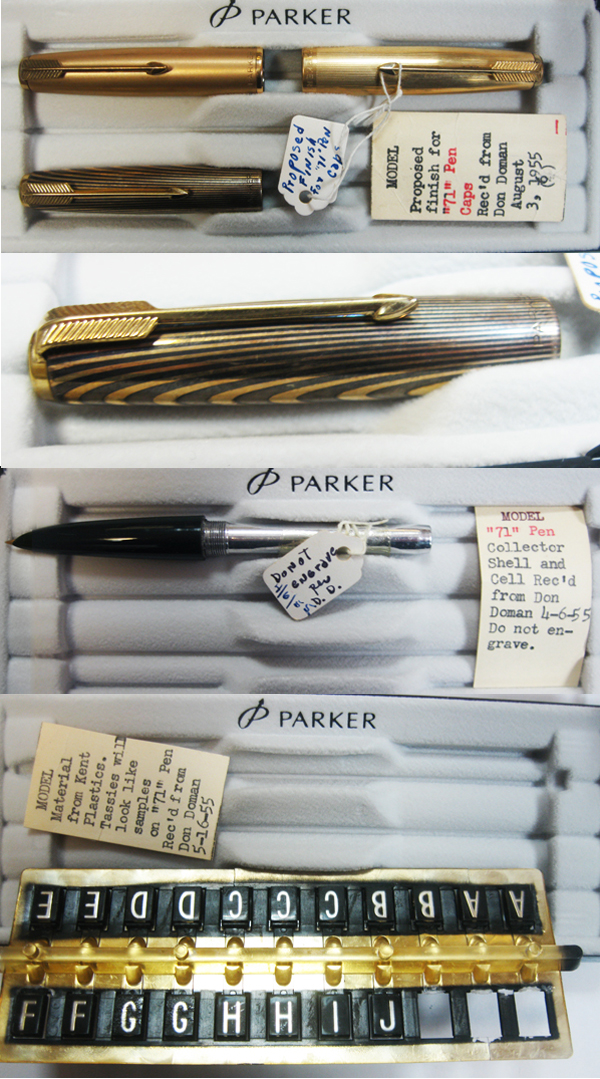 Photography © 2009 by Tony Fischier courtesy of The Parker Pen Company Archives. |
Parker "71" parts from the Experimental Archives. |
|
Curiously enough there was a memo from Kenneth Parker's son Daniel Parker from October 1955 where he stipulated that the new pen should be referred to as the Parker "61" mk II, and the Parker "71" name was promptly dropped. Kenneth Parker had stepped down as president in 1952, but remained as chairman. So, eventually in september 1956 the new pen was introduced in the US. Europe was not to see the revolutionary pen until some five years later. |
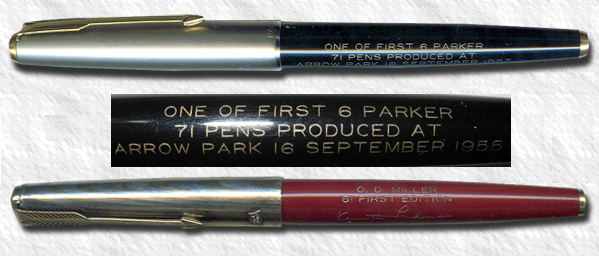 Photography ©2009 by and courtesy of Itzak "Tsachi" Mitsenmacher. |
Two phenomenal Parkers, one of the first six Parker "71" made, followed by a first edition Parker "61", with the signature of Kenneth Parker on the barrel. |
|
|
The nib assembly was similar to that of the "51", featuring a tubular 14K gold nib ("Plathenium" tipped) with a Lucite feed inside and a collector around, inside the gripping section shell. |
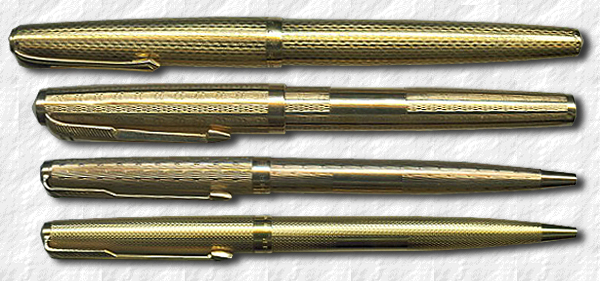 Photography ©2009 by and courtesy of Itzak "Tsachi" Mitsenmacher. |
Some phenomenal Presidential Parker "61"s. |
|
Parker ads from 1957 and 1956. |
Parker offered seven different "Electro-Polished" point styles in nibs: In 1957 The Heritage rainbow cap in silver and yellow gold was introduced. A Demonstrator was made to show the novel filling mechanism. Also a Liquid Lead pencil was introduced for the line.
|
The line-up in 1958: Before christmas 1958 two new high end designs was added to the line, the Insignia, with a gold filled cap and barrel and rolled gold clip, this pen was initially referred to as the Jet Flighter, it's also referred to as the Signet. They came in the attractive finishes of The second pen was the Presidential, with solid 14K cap, barrel and clip. In 1959 the Parker "61" Flighter in stainless steel with chrome plated trim was introduced while the rainbow cap Legacy in silver and nickel was discontinued as well as the Heritage in silver and yellow gold. The barrel colour Surf Green was also discontinued. In 1961 the finishes offered were:
|
©2009 Image courtesy of Francis Meinhardt and The Parker Pen Company Archives. |
A Parker "51" prototype fitted with the capillary filer. |
In 1962 the Parker "61" Flighter with chrome plated trim was discontinued. The same year the ring between the section and pen body was made thinner, also the cap was shortened a little bit from 62 millimeters to 60 millimeters, these pens are considered by collectors to be the Parker "61" mk II (app. 135 mm long). The Liquid Lead pencil was also discontinued as well as the Demonstrator. In 1963 Lustraloy cap with a chrome clip replaced the DeLuxe In 1964 the DeLuxe model with rolled gold trim was discontinued. The same year the Parker "61" was introduced in the UK. These pens were offered with the Heirloom rainbow cap only. In 1965 the UK line comprised of: |
In 1966 the following models were offered in the UK: In 1967 the Parker "65", wich was very similar to the Parker "61" but with an open nib, was introduced. The ball point pens was made to compliment both lines. Also in 1967 Parker in the UK introduced a Parker "61" line called Consort, which had a cap that held twice the gold of the Insignia, in 12 carat rolled gold cap and barrel in an intricate "brick" or grid pattern with deep lines. This replaced the last of the rainbow caps; the Heirloom in green and pink gold which was discontinued. Models in 1967:
|
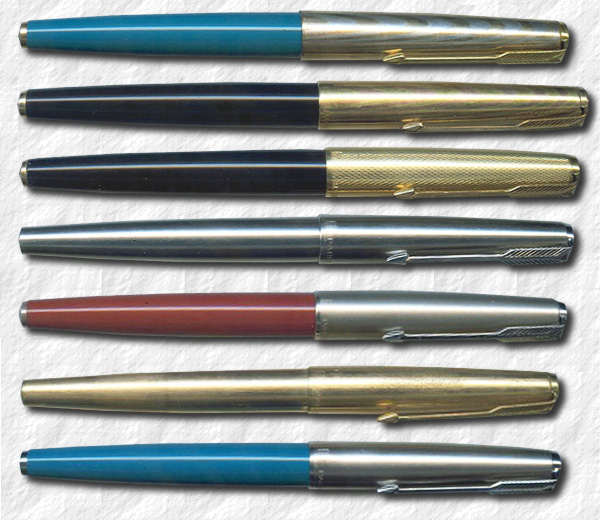 Photography ©2009 by and courtesy of Itzak "Tsachi" Mitsenmacher. |
From the top: |
1969 also saw the introduction of new barrel colours. The Caribbean green and Rage Red was discontinued and the colour line-up was: The Presidential was now offered in two new designs: In 1970 a Flighter deLuxe model with rolled gold trim was introduced for both the Parker "61" and Parker "65" lines. By 1971 a Presidenial 14K solid gold desk pen with a short black taper was offered for $75. |
In 1972 the Consort insignia model was discontinued. In 1973 the Presidential desk pen was phased out. In 1976 the felt-tipped Parker "61" was introduced. In 1977 The Parker "61" custom with the rolled gold cap was discontinued, as well as the desk set. In 1979 the felt-tipped Parker "61" was phased out. In 1982 the cloud series, Cirrus, Stratus and Cumulus was discontinued. In 1983 both the 9 and 14 carat solid gold Presidential Parker "61" were discontinued. They were the last of the Parker "61"s. |
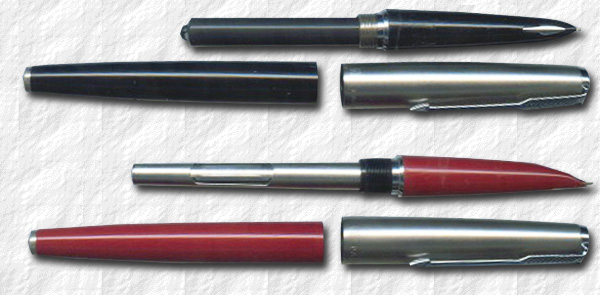 Photography ©2009 by and courtesy of Itzak "Tsachi" Mitsenmacher. |
The two filling systems, capillary filler (1956—1969) and cartridge filler (1970—1983) |
© 1995-2019 Tony Fischier and The Parker Pen Company®/Sanford Ecriture.
This page is in no way sponsored by or created by the Parker Pen Company®. All opinions, views, and thoughts expressed herein are expressly the authors, and in no way reflect the opinions, views, or thoughts of the Parker Pen Company®/Sanford Ecriture. All logos and/or images on these pages are © Copyright of Parker Pen Company®Sanford Ecritureunless otherwise stated and is reprinted by kind permission. If You feel that Your copyright has been violated please contact the WEBMASTER.
Everything on this website is copyrighted by law and can not be used without written permission from the author, Tony Fischier. You may however use the information as reference material and although it is forbidden to make digital copies or reproductions it may be physically printed for personal use, which does not include use on other web pages or in advertising. You may however quote parts of the content of this website, digitally or physically, providing that the source and author is clearly stated, together with the copyright information. In the US referred to as Fair use. If you use any information on this site, add a link.
Feel free to donate a small sum through Paypal to help this site to stay online. Acknowledgements.
Parkercollector.com in translated versions
